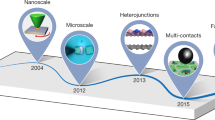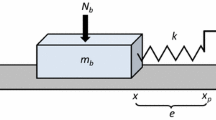Summary
Friction and wear has been a major problem for many micro actuators. The friction and wear properties in micro scale have been investigated experimentally by many research institutions using both scientific instrumentation and microstructures of practical dimensions. Based on the experimental results, models for micro friction are discussed and the different friction properties for micro and macro scales are compared. The measures to mitigate the friction and wear problem are introduced.
Access this chapter
Tax calculation will be finalised at checkout
Purchases are for personal use only
Preview
Unable to display preview. Download preview PDF.
Similar content being viewed by others
References
M. P. de Boer, Jim M. Redmond, T. A. Michalske, “A hinged-pad test structure for sliding fricition measurement in micromachining”, Proc. SPIE, Vol. 3512, pp. 241–250, Santa Clara, CA, 1998.
D. M. Tanner, “Reliability of Surface Micromachined MEMS Actuators” Proc. 22nd International Conference in Microelectronics, Nis, Yugoslavia, pp. 97–104, May 2000.
K. S. Breuer, et al, “Challenges for High-Speed Lubrication in MEMS”, Nano Tribology. Ed. S. Hsu. Kluwer Press, 2000.
B. Bhushan and V. N. Koinkar, “Tribological Studies of Silicon for Magnetic Recording Applications”, J. Appl. Phys. Vol. 75, No. 10, pp. 5741–5746, 1994.
U. Beerschwinger, R. L. Reuben, S. J. Yang, “Frictional study of micromotor bearings”, Sensors and Actuators, A63, pp. 229–241, 1997.
R. Maboudian, “Surface Processes in MEMS Technology”, Surface Science Reports, Vol. 30, pp. 207–269, 1998.
B. Bhushan, J. N. Israelachvili and U. Landman, “Nanotribology, wear and lubrication at the atomic scale” Nature, Vol. 374, No. 13, pp. 607–616, 1995.
B. Bhushan, C. Dandavate, “Thin-film friction and adhesion studies using atomic force microscopy”, Journal of Applied Physics, Vol. 87, No. 3, pp. 1201–1210, 2000.
U. D. Schwarz, O. Zworner, P. Koster, R. Wiesendanger, “Quantitative Analysis of the Frictional properties of Solid Materials at low Loads. I. Carbon Compounds”, Physical Review B, Vol. 56, No. 11, pp. 6987–6996, 1997.
A. G. Khurshudov, K. Kato, H. Koide, “Wear of the AFM diamond tip sliding against silicon”, Vol. 22–27, pp. 203–204, 1997.
R. Prasad, N. MacDonaldl and D. Tayor, “Micro-instrumentation for Tribological Measurement”, Proc. Transducers’ 95, Vol. II, pp. 52–55, 1995.
N. R. Tas, C. Gui, and M. Elwenspoek, “Static Friction in Elastic Adhesive MEMS Contacts, Models and Experiment”, Proc. MEMS-2000, IEEE.
S. L. Miller, J. J. Sniegowski, G. LaVigne, P. J. McWhorter, “Performance Tradeoffs for a Surface Micro machined Micro engine”, Proc. SPIE, Austin, TX, Oct 14–15, Vol. 2882, pp.182–191, 1996.
G. He, M.H. Muser, M. O. Robbins, “Adsorbed Layers and the Origin of Static Friction”, Science, Vol. 284, pp. 1650–1652, 1999.
K. L. Jonhnson, “Contact Mechanics”, Cambridge University Press, Cambridge, 1985.
Q. Chen, G.P. Carman, “Microscale tribology (friction) measurement and influence of crystal orientation and fabrication process”, Proc. of Microscale Systems: Mechanics and Measurements Symposium, 25. 2000.
X. D. Wang, Z. Y. Chen, X. H. Liu, W. Y. Wang, “Friction Coefficient and Wearing Properties of Amorphous Diamond Films Deposited on Si, Ni and Cu Substrates”, Proc. Intl. Conf. Nanotechnologies for the future, Houston, TX, USA, 2000.
J. Sakata, T. Tsuchiya, A. Inoue, et al, “Anti-stiction Silanization Coating to Silicon Microstructures by a Vapor Phase Deposition Process”, Proc. Transducers’99, Paper No. 1A3-2, 1999.
L. Howald, R. Luthi, E. Meyer and H. J. Guntherodt, “Atomic-force Microscopy on the Si(111) 7×7 Surface”, Physical Review B, Vol. 51, No. 8, pp. 5484–5487, 1995-II.
P. M. Sarro, “Silicon Carbon as a New MEMS Technology”, Sensors and Actuators, Vol. 82, pp. 210–218, 2000.
Author information
Authors and Affiliations
Editor information
Editors and Affiliations
Rights and permissions
Copyright information
© 2001 Springer-Verlag Berlin Heidelberg
About this paper
Cite this paper
Wang, W., Wang, Y., Bao, H., Xiong, B., Bao, M. (2001). Friction and Wear Properties of Microstructures in MEMS. In: Obermeier, E. (eds) Transducers ’01 Eurosensors XV. Springer, Berlin, Heidelberg. https://doi.org/10.1007/978-3-642-59497-7_312
Download citation
DOI: https://doi.org/10.1007/978-3-642-59497-7_312
Publisher Name: Springer, Berlin, Heidelberg
Print ISBN: 978-3-540-42150-4
Online ISBN: 978-3-642-59497-7
eBook Packages: Springer Book Archive




